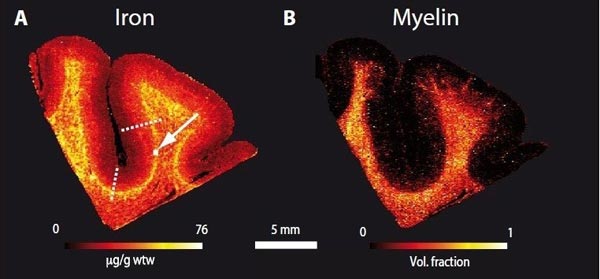What lies between grey and white in the brain

The team created very high resolution maps of the white-grey matter border across the entire living brain.
© MPI CBS
Traditionally, neuroscience regards the brain as being made up of two basic tissue types. Until very recently, not much was known about the interface between the white and grey matter – the so-called superficial white matter. Little was known about this thin region linking the grey and white matter because methods were lacking to study it in living human brains. Yet, previous investigations had suggested the region to be implicated in devastating conditions such as Alzheimer’s disease and autism. Now a multidisciplinary team led by Nikolaus Weiskopf from the MPI CBS has succeeded in making the superficial white matter visible in the living human brain.
Traditionally, neuroscience regards the brain as being made up of two basic tissue types. Billions of neurons make up the grey matter, forming a thin layer on the brain’s surface. These neuronal cells are interlinked in a mindboggling network by hundreds of millions of white matter connections, running in bundles, deeper in the brain.
Until very recently, not much was known about the interface between the white and grey matter – the so-called superficial white matter. Little was known about this thin region linking the grey and white matter because methods were lacking to study it in living human brains. Yet, previous investigations had suggested the region to be implicated in devastating conditions such as Alzheimer’s disease and autism.
Now a multidisciplinary team led by Nikolaus Weiskopf from the Max Planck Institute for Human Cognitive and Brain Sciences (MPI CBS) has succeeded in making the superficial white matter visible in the living human brain.
“We demonstrated that the superficial white matter contains a lot of iron. It is known that iron is necessary for the process of myelination,” explains Evgeniya Kirilina, first author of the study published in Science Advances. Myelin is what makes the white matter white. It’s the fatty coating of nerve cell axons that speeds up transmission of information through the brain. The myelination process can occur throughout the lifespan but is predominant during development.
In fact, the largest concentration of iron the researchers found was in the superficial white matter in regions of the frontal cortex, which happens to be the slowest developing structure in the human brain. Incredibly, the human frontal cortex is not fully myelinated until the forth decade of life.
The key to the new method is MRI (Magnetic Resonance Imaging) but at very high field strength. While typical clinical MRI scanners work at 1.5 or 3 Tesla, in terms of the strength of the magnetic field, the MPI CBS houses a powerful 7 Tesla scanner. This, in combination with advanced biophysical model, allowed the team to create very high resolution maps of the white-grey matter border across the entire living brain.
The accuracy of their submillimetre maps was assessed against classic and advanced histological methods involving physical dissection and analysis of post mortem brains.
The new method promises many further insights into the organisation of the interface between white and grey matter. Evgeniya Kirilina adds, “We hope the method can be used to increase our understanding of brain development as well as pathological conditions involving the superficial white matter.”
Wissenschaftliche Ansprechpartner:
Prof Nikolaus Weiskopf
Director Neurophysics
weiskopf@cbs.mpg.de
Dr Evgeniya Kirilina
Scientific researcher Neurophysics
kirilina@cbs.mpg.de
Originalpublikation:
Evgeniya Kirilina, Saskia Helbling, Markus Morawski, Kerrin Pine, Katja Reimann, Steffen Jankuhn, Juliane Dinse, Andreas Deistung, Jürgen R. Reichenbach, Robert Trampel, Stefan Geyer, Larissa Müller, Norbert Jakubowski, Thomas Arendt, Pierre-Louis Bazin, Nikolaus Weiskopf
“Superficial white matter imaging: Contrast mechanisms and whole-brain in vivo mapping”
in Science Advances: https://advances.sciencemag.org/content/6/41/eaaz9281
Weitere Informationen:
https://www.cbs.mpg.de/1607817/news_publication_15497544_transferred?c=7533
https://www.mpg.de/15497544/what-lies-between-grey-and-white-in-the-brain
Media Contact
All latest news from the category: Interdisciplinary Research
News and developments from the field of interdisciplinary research.
Among other topics, you can find stimulating reports and articles related to microsystems, emotions research, futures research and stratospheric research.
Newest articles

Why getting in touch with our ‘gerbil brain’ could help machines listen better
Macquarie University researchers have debunked a 75-year-old theory about how humans determine where sounds are coming from, and it could unlock the secret to creating a next generation of more…

Attosecond core-level spectroscopy reveals real-time molecular dynamics
Chemical reactions are complex mechanisms. Many different dynamical processes are involved, affecting both the electrons and the nucleus of the present atoms. Very often the strongly coupled electron and nuclear…

Free-forming organelles help plants adapt to climate change
Scientists uncover how plants “see” shades of light, temperature. Plants’ ability to sense light and temperature, and their ability to adapt to climate change, hinges on free-forming structures in their…





















